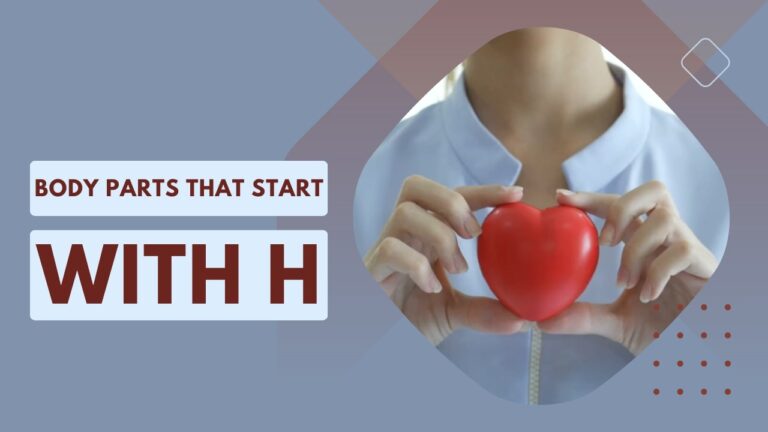I’m delighted to see your interest in exploring the fascinating world of human anatomy, specifically focusing on the captivating realm of body parts that start with the letter “H.” You’ve come to the perfect spot for a comprehensive list that will undoubtedly enrich your understanding of our intricate biology.
Within this enlightening article, you’ll encounter an extensive compilation of human body elements, each beginning with the captivating and distinctive letter “H.” This compilation serves as an opportunity to dive deep into the incredible diversity and complexity of our physiological makeup, shedding light on both the familiar and the lesser-known aspects.
As you immerse yourself in this exploration, you’ll come across an array of intriguing structures and functions that together form the remarkable tapestry of the human body. From the delicate hair that adorns our skin to the commanding heart that orchestrates our life-sustaining rhythm, and from the graceful helix of the ear to the resilient bones of the hip, each entry unveils a unique facet of our existence.
But first, before we dive into the letter H, did you start at the beginning of the alphabet? Find out what parts in our body start with the letter A.
List Of Body Parts That Start With H:
Here is the list of everything of body parts including eyes, ears, bones, cartilage are given below:
| Term | Description |
|---|---|
| Haldane Effects | Describes the phenomenon where deoxygenation of blood increases its capacity to carry carbon dioxide. |
| Hair End Organ | Sensory receptor in the skin responsible for detecting hair movement and position. |
| Hallucinations | Sensations or perceptions that appear real but are created by the mind, often unrelated to external stimuli. |
| Hippocampal Seizure | Seizure originating in the hippocampus, a region in the brain associated with memory and spatial navigation. |
| Haustrations | Contraction of circular muscles in the colon that create pouches known as haustra, aiding in bowel movement. |
| Haversian Canal | Microscopic channels in bones containing blood vessels and nerves, playing a role in nutrient exchange. |
| HDL | High-Density Lipoprotein; a lipoprotein that transports cholesterol from tissues to the liver for processing. |
| Heartbeat | Rhythmic contraction and relaxation of the heart that propels blood throughout the circulatory system. |
| Heat Loss | Dissipation of excess body heat to maintain a stable internal temperature. |
| Heart Launching Machine | Not a recognized term in medical or biological contexts. |
| Heat Production | Generation of metabolic heat as a result of cellular processes and physical activity. |
| Helium | A chemical element, often used in cryogenic applications and as a tracer gas in medical tests. |
| Heme | Iron-containing molecule in hemoglobin and myoglobin that binds and carries oxygen. |
| Helium Dilution Method | A technique for measuring lung capacity and determining lung diseases using helium as a diluent gas. |
| Hemiballismus | A rare neurological movement disorder characterized by involuntary, violent, and large-amplitude movements. |
| Hering’s Nerve | Also known as the vestibular nerve, it carries sensory information related to balance and spatial orientation. |
| Histidine | An amino acid used in protein synthesis and as a precursor for histamine, among other functions. |
| Hinges | Synovial joints that allow movement along a single axis, like the elbow or knee joint. |
| Hippocampus | A region in the brain associated with memory consolidation, learning, and spatial navigation. |
| Hypothalamus | Part of the brain involved in various physiological functions, including regulation of body temperature. |
| Hindbrain | The posterior part of the brain, including the cerebellum, pons, and medulla, involved in basic functions. |
| Horizontal Cells | Neurons in the retina that facilitate lateral communication between photoreceptor cells. |
| Histamine | A neurotransmitter involved in various physiological processes, including allergic responses. |
| Hematocrit | The volume percentage of red blood cells in the total blood volume, a marker of blood’s oxygen-carrying capacity. |
| Hematopoietic Stem Cells | Precursor cells that give rise to various types of blood cells, crucial for the immune and circulatory systems. |
| Hemoglobin | Protein in red blood cells that binds oxygen and carries it to tissues, also helping transport carbon dioxide. |
| Hemolysis | The rupture or destruction of red blood cells, releasing hemoglobin into the bloodstream. |
| Hemolysins | Substances that cause hemolysis, often produced by bacteria. |
| Hemophilia | Genetic disorder affecting blood clotting, leading to prolonged bleeding and bruising. |
| Hemolytic Jaundice | Jaundice caused by the breakdown of red blood cells, resulting in an excess of bilirubin. |
| Hemorrhagic Shock | Life-threatening condition where severe bleeding leads to inadequate blood circulation and oxygen delivery. |
| Hemorrhage | Abnormal and excessive bleeding, often due to injury or internal rupture. |
| Hemodialysis | Medical procedure to filter waste products and excess fluids from the blood when kidneys are not functioning. |
| Hemosiderin | Protein complex that stores iron in cells, often seen in tissues after iron overload or injury. |
| Henderson-Hasselbalch Equation | A formula relating the pH, pKa, and the concentrations of a weak acid and its conjugate base in a solution. |
| Henry’s Law | Describes the solubility of a gas in a liquid, stating that the amount of gas dissolved is proportional to pressure. |
| Hepatitis | Inflammation of the liver, often caused by viral infections, toxins, or autoimmune disorders. |
| Heparin | Anticoagulant medication that prevents blood clot formation and is naturally produced by the body. |
| Hepatic Artery | Blood vessel that supplies oxygenated blood to the liver. |
| Hepatic Arterioles | Small arteries within the liver that further distribute blood to hepatic tissue. |
| Hepatic Coma | Severe complication of liver disease where the brain function is impaired due to accumulation of toxins. |
| Hepatitis | Inflammation of the liver, often caused by viral infections, toxins, or autoimmune disorders. |
| Herpes Zoster | Viral infection causing painful skin rash and blisters, commonly known as shingles. |
| Hemophiliac | A person with hemophilia, a genetic disorder affecting blood clotting. |
| Hemiballismus | A rare neurological disorder causing involuntary, forceful, and wide-ranging movements. |
| Hepatocytes | Liver cells responsible for various metabolic functions, including detoxification and protein synthesis. |
| Hepatocyte Growth Factor | Protein that stimulates cell growth and repair, often involved in liver regeneration. |
| Hereditary Spherocytosis | Inherited disorder causing spherical-shaped red blood cells, leading to anemia and other complications. |
| Hearing Breuer Inflation Reflex | Protective reflex preventing overinflation of the lungs during deep inspiration. |
| Hermaphroditism | A condition in which an individual possesses both male and female reproductive organs. |
| Hexagonal Reference System | A coordinate system with six-fold rotational symmetry, commonly used in crystallography. |
| Hexokinase | Enzyme that facilitates the first step of glucose metabolism by converting glucose to glucose-6-phosphate. |
| High-Density Lipoprotein (HDL) | Lipoprotein that carries cholesterol from peripheral tissues to the liver for excretion, “good” cholesterol. |
| High Energy Phosphate Compound | Molecules like ATP and creatine phosphate, storing and transferring energy within cells. |
| Hippocampus | Brain structure involved in memory consolidation, learning, and spatial navigation. |
| His Bundle | Part of the heart’s electrical conduction system, transmitting signals between the atria and ventricles. |
| Histamine | A neurotransmitter and immune system mediator involved in allergic responses and gastric acid secretion. |
| HLA | Human Leukocyte Antigen; proteins regulating the immune system’s recognition of self and non-self cells. |
| HMG-CoA Reductase | Enzyme targeted by statin drugs that plays a crucial role in cholesterol synthesis. |
| Human Leukocyte Antigen Complex | A group of genes that encode proteins involved in immune response regulation and tissue compatibility. |
| Homonymous Hemianopsia | Visual field loss in both eyes on the same side, often caused by lesions in the brain’s visual pathways. |
| Horizontal Cells | Neurons in the retina responsible for lateral communication between photoreceptor cells. |
| Hormone Response Element | Specific DNA sequences binding with hormone-receptor complexes, influencing gene expression. |
| Hormone-Gated Receptors | Cell membrane receptors activated by hormones, leading to cellular responses. |
| Hormone-Sensitive Lipase | Enzyme that breaks down triglycerides into fatty acids and glycerol in response to hormonal signals. |
| Hirschsprung Disease (Hirschsprung) | Congenital disorder causing the absence of nerve cells in parts of the colon, leading to bowel problems. |
| HIV | Human Immunodeficiency Virus; virus causing acquired immunodeficiency syndrome (AIDS). |
| HDL | High-Density Lipoprotein; a lipoprotein that transports cholesterol from tissues to the liver for processing. |
| Histones | Proteins that help package DNA into chromatin, playing a role in gene regulation and chromosome structure. |
| Histiocytes | Immune cells that originate from monocytes and are involved in immune response and inflammation. |
| HLA | Human Leukocyte Antigen; proteins regulating the immune system’s recognition of self and non-self cells. |
| Homeostasis | The body’s ability to maintain a stable internal environment despite external changes, ensuring optimal function. |
| Hormones | Signaling molecules produced by glands and tissues, regulating various physiological processes in the body. |
| Human Chorionic Somatomammotrophin | Also known as human placental lactogen (HPL), a hormone produced during pregnancy, affecting metabolism. |
| Human Chorionic Thyrotropin | Hormone produced during pregnancy, similar in structure to thyroid-stimulating hormone (TSH). |
| Human Growth Hormone (GH) | Hormone produced by the pituitary gland that stimulates growth, cell reproduction, and regeneration. |
| Human Chorionic Gonadotropin (hCG) | Hormone produced during pregnancy, detected in pregnancy tests and supporting the corpus luteum. |
| Human Leukocyte Hormone | Not a recognized term in medical or biological contexts. |
| Human Leukocyte Antigen | Proteins encoded by HLA genes, essential for immune system recognition and functioning. |
| Human Placental Lactogen | Hormone produced during pregnancy that influences maternal metabolism and fetal development. |
| Humoral Immunity | Immune response involving antibodies and B cells, providing defense against pathogens in body fluids. |
| Hyaluronic Acid | A glycosaminoglycan found in connective tissues, responsible for lubrication, hydration, and tissue repair. |
| Hyaluronidase | Enzyme that breaks down hyaluronic acid, involved in tissue remodeling and facilitating cell movement. |
| Hydrochloric Acid | Strong acid produced by the stomach to aid in digestion by breaking down food and killing pathogens. |
| Hydrocortisone | A corticosteroid hormone produced by the adrenal glands, involved in regulating metabolism and immune response. |
| Hydrogen ATPase | Enzyme responsible for transporting hydrogen ions across cell membranes, essential for pH regulation. |
| Hydrogen Bonding | Attractive interaction between a hydrogen atom and an electronegative atom, influencing molecular properties. |
| Hydrogen Enzymes | Not a specific term; enzymes involved in hydrogen metabolism or related processes. |
| Hydrogen Peroxide | Chemical compound with disinfectant properties, produced by cells as a byproduct of metabolism. |
| Hydrogen Potassium ATPase Pump | Enzyme responsible for pumping hydrogen ions into the stomach, aiding in gastric acid secretion. |
| Hydrolase Enzyme | Enzyme that catalyzes hydrolysis reactions, breaking down complex molecules into simpler ones using water. |
| Hydrolysis | Chemical reaction involving the breakdown of a compound through the addition of water molecules. |
| Hydronephrosis | Swelling of the kidney due to the accumulation of urine caused by obstruction of the urinary tract. |
| Hydroxyapatite | Mineral form of calcium phosphate that constitutes a significant portion of bone tissue and teeth. |
| Hyperalgesia | Increased sensitivity to pain, often resulting from damage to or dysfunction of the nervous system. |
| Hyperbarism | Medical condition caused by exposure to high atmospheric pressure, often involving breathing compressed air. |
| Hyperbilirubinemia | Elevated levels of bilirubin in the blood, leading to jaundice and potentially indicating liver dysfunction. |
| Hypercalcemia | Elevated levels of calcium in the blood, which can lead to various health issues, including kidney stones. |
| Hypercapnia | Excessive carbon dioxide levels in the blood, often leading to respiratory and metabolic acidosis. |
| Hyperemia | Increased blood flow to a particular tissue or organ, often causing redness and warmth. |
| Hyperglycemia | Elevated levels of glucose (sugar) in the blood, often associated with diabetes or other metabolic disorders. |
| Hyperinsulinism | Excessive production or release of insulin, leading to low blood sugar levels (hypoglycemia). |
| Hyperlipidemia | Elevated levels of lipids (fats) in the blood, a risk factor for cardiovascular diseases. |
| Hypernatremia | Elevated levels of sodium in the blood, often due to dehydration or other underlying conditions. |
| Hyperopia | Commonly known as farsightedness, a vision condition where distant objects are seen more clearly than nearby. |
| Hyperpolarization | Change in the electrical potential of a cell membrane, making it more negative and less likely to fire. |
| Hyperparathyroidism | Overactivity of the parathyroid glands, leading to excessive production of parathyroid hormone (PTH). |
| Hypocalcemia | Low levels of calcium in the blood, potentially causing muscle cramps, seizures, and other health issues. |
| Hypogastric Plexus | A network of nerves in the lower abdomen, regulating various functions, including digestion and urination. |
| Hypochromic Anemia | Type of anemia characterized by red blood cells with reduced hemoglobin content, often leading to paleness. |
| Hypoeffective Heart | Heart with reduced contractile force, often leading to decreased pumping efficiency and cardiac output. |
| Hypoglycemia | Abnormally low levels of glucose (sugar) in the blood, potentially causing symptoms like dizziness and fainting. |
| Hypothyroidism | Underactive thyroid gland, leading to a decrease in thyroid hormone production and various health issues. |
| Hypotonia | Reduced muscle tone and strength, often seen in conditions affecting the nervous system or muscles. |
| Hypoventilation | Inadequate breathing that results in reduced oxygen intake and increased carbon dioxide levels in the blood. |
| Hypoxia | Insufficient oxygen supply to tissues, often leading to cell damage and potentially life-threatening conditions. |
Human Body Parts That Start With The Letter H:
Here are also some human body parts lust that starts with the alphabet h:
| Body Part | Description |
|---|---|
| Hair | Thin, thread-like structures that grow on the skin’s surface, composed of protein and originating from hair follicles. |
| Hand | The distal part of the upper limb, including the palm, fingers, and thumb, used for grasping and manipulating objects. |
| Hair Cells | Specialized cells found in the inner ear responsible for converting sound vibrations into electrical signals. |
| Hair Tufts | Small clusters of hair on the body, often seen in certain patterns or locations. |
| Hard Palate | The bony front part of the roof of the mouth, separating the oral and nasal cavities. |
| Hamate | One of the small bones in the human wrist, located on the ulnar (pinky finger) side. |
| Hamulus of Hamate | A hook-like projection on the hamate bone in the wrist. |
| Head | The uppermost part of the body, containing the brain and sensory organs such as the eyes, ears, and nose. |
| Heart | A muscular organ responsible for pumping blood throughout the circulatory system. |
| Heel | The back part of the foot, forming the base of the rear portion of the foot. |
| Hepatic Vein | Blood vessels that carry deoxygenated blood from the liver to the inferior vena cava. |
| Hepatic Artery | Blood vessel that supplies oxygenated blood to the liver. |
| Hepatic Sinuses | Vascular spaces within the liver tissue that facilitate blood flow and nutrient exchange. |
| Helix | The outer rim or edge of the external ear, often referred to as the “ear’s edge.” |
| Hip | The joint connecting the thigh bone (femur) to the pelvis, allowing for movement and weight-bearing. |
| Hindbrain | The posterior part of the brain, including the cerebellum, pons, and medulla oblongata. |
| Hip Bone | The large, flat bone that forms the lateral sides and base of the pelvis. |
| Hymen | A thin membrane that partially covers the opening of the vagina in some females. |
| Humerus | The long bone of the upper arm, connecting the shoulder to the elbow. |
By the way, if you want to know how the body parts work you can check this video:
Final Words
In short, it can be said that from this article you can get a better idea about the body part that starts with H. If there is anything missing about the human body parts that start with the letter H, you can let us know by commenting here below.
If you find this article useful, share it with the people around you and give them the opportunity to increase their knowledge. Have a good day.
Related Posts:
- Human Body Parts That Start With A - List Explained
- Human Body Parts That Start With D -List Explained
- Human Body Parts That Start With E -List Explained
- Human Body Parts That Start with G - List Explained
- List Of Human Body Parts That Start With I - Inside and Out
- List Of Disney Characters That Start With R - List Explained








